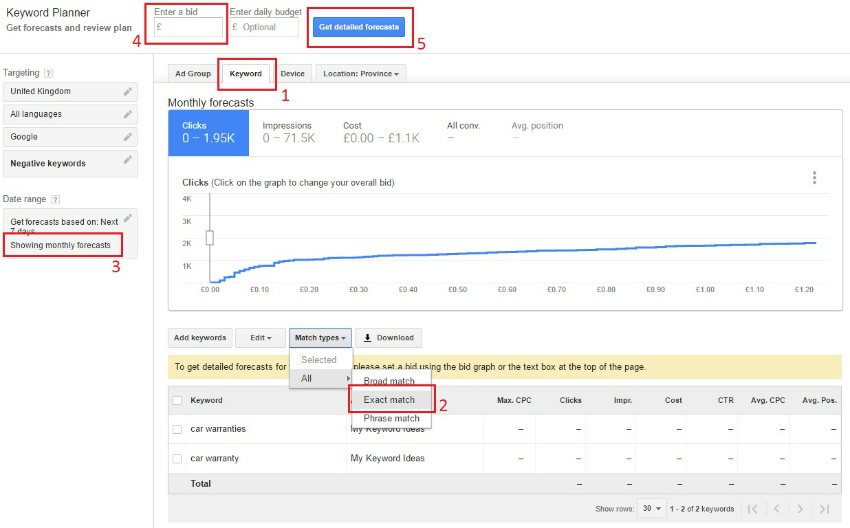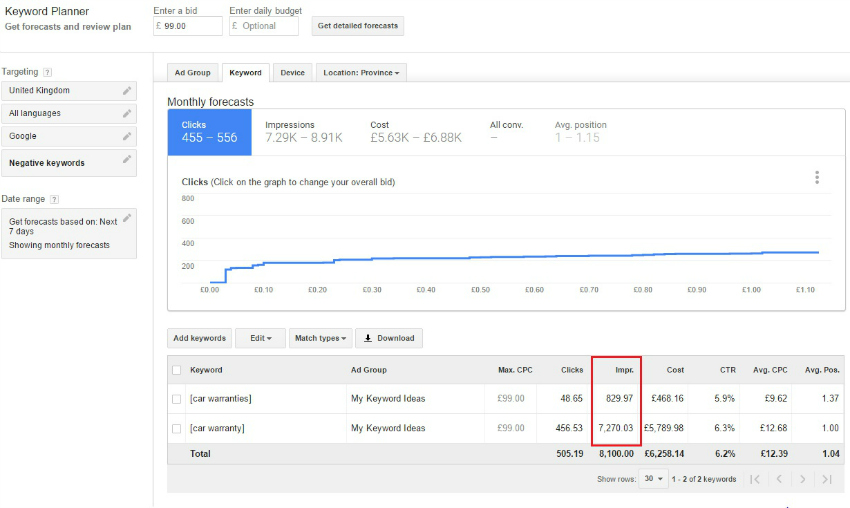How To Get More Accurate Search Volume Data In Google Keyword Planner
Paudy Heal
Posted 22 August, 2016 by Paudy Heal in SEO
How To Get More Accurate Search Volume Data In Google Keyword Planner
You’ll have likely noticed some big changes to the Google Keyword Planner tool recently – namely that it now groups together the search volume data for many similar keyword variants.
For example, if you research ‘car warranty’ and ‘car warranties’ you will see that they each have an estimated average monthly search volume of 8,100. This could be misinterpreted as a total of 16,200 searches for the two keywords collectively, whereas in reality the 8,100 number refers to the volume of both of these variants combined. These changes have been summed up excellently here. There have also been cases of Google suppressing the data for low spending advertisers, as detailed here.
The Benefits of Obtaining More Granular Keyword Data
Keyword research is an essential activity at various stages of an SEO campaign. Comprehensive research can help to identify a range of new opportunities, and obtaining the most accurate and telling data possible can lead to much more precise forecasting when evaluating the potential traffic opportunities for you or your clients’ websites.
Let’s continue with the ‘car warranty’ and ‘car warranties’ example. The likelihood is that one of variants will be more valuable, be more competitive, and have a higher search volume than the other – but how can we decipher which one now that Google combines the data within the tool?
Take this small sample from a keyword research document, where the new combined data that Google now provides is evident:

Wouldn’t it be far more useful to still have more distinct and clear-cut numbers like the ones below to work from and forecast from instead?

There are a few incredibly quick and easy steps you can take within the Keyword Planner tool that will allow you to see these divided impression numbers, despite the recent update.
How To Get This Keyword Data
First, click on the arrows next to the all of the keywords you want more specific data for, and this will add them to your plan. Note that the search volumes for these each say 8,100 at this stage. When you’re ready, click on the ‘Review plan’ button:


The next page you see should look something like this, minus all of the red boxes of course:

As you can see by the labels above, there are five things you need to check, adjust, or click in order to get the results you need:
- Click on the ‘Keyword’ tab
- Click on ‘Match types’ > ‘All’ > ‘Exact match’
- Double check that the date range is set to display forecasts by month
- Enter a bid of £99, as entering a maximum bid will ensure you’re only seeing impressions based on first page results
- Finally, when you’re ready to go, click on the ‘Get detailed forecasts’ button
Et voila. The table should then update, displaying much more accurate impression data, and providing the average monthly search volumes similar to those you’ve been used to seeing prior to the tool’s update:

You’ll need to round these numbers up or down to a degree, but you can see that instead of both of these particular keywords having an average monthly search volume of 8,100 each, ‘car warranty’ in fact has approximately 7,300 searches, and the plural ‘car warranties’ has just 800 searches in comparison.
You can now download this data and start to compile keyword research that tells a much more accurate story, as you saw earlier:



I hope this quick guide can act as a handy point of reference next time you perform some keyword research. If you’ve found any alternative ways to discover these more specific numbers within Keyword Planner since its update, let us know in the comments.






Isn’t the impression vary depending on bid we put on the input box1?
So in this case, estimated impressions for the singular is some 10 that of the plural and that is a great illustration and I am able to get this to work per your excellent instructions. It is a bit tricky in the download as the column containing the good stuff is not quite exactly where you expect it to be – but it is worth finding.
However, where you show some 7,000 impressions for the singular, it is unclear for what time period that is estimated for – is that for 7 days (in the future)?
Hi Paudy, great article in how to obtain more granular data from Keyword Planner. Now, it’s even worse, from a broader search volume data, they moved to providing us with an approximation in thousands (i.e. 1K-10K)
What if the SERP for a query doesn’t have ads? Then the Impressions column won’t give any data but the Average Monthly Search Volume was in the past? I’ve seen a vast difference between both metrics in certain terms.
What is the most recommended external tool to use as a keyword search volume data then?
Thank you,
This latest change in keyword planner is something that has had everyone in the SEO world talking this week!
Thanks for helpful article.
When I did “reactores quimicos”
I get
reactores quimicos
reactor quimico
Both with 720 Monthly search
With your technique, I am able to find the exact volume. And it is 1119 and 240 respectively.
Thanks again.
Bhavesh Desai
P.S- Thanks for Screamming frog too!!
First of all, let me thank you for this helpful post. The other thing I would like to say that with this new system of showing ranges for avg. searches instead of the exact numbers, it has really become difficult to do keyword research.
This method is useful to find out the exact number of searches per a keyword. However, I heard that Keyword Planner tool of Google Adwords is no longer allow us to see exact number of searches anymore.
Does this information is correct? Or it’s only valid for free users, who don’t actually have an account with an active campaign?
does anyone know of an alternative to google keyword tool? the search volume data it displays now is absolutely useless.
@wali : you can try playing with semrush, but i think they use google’s old datas.
Great post.
Question: “We know this is the case because Google Keyword Planner also exposes the last 12 months of traffic data” where can you find this? I’ve been searching and exploring but can only ever find monthly search volumes? How do you see traffic estimates as a yearly total?
This doesn’t appear to work anymore. I get 0 impressions for my keywords.
Thanks for the tip but it’s not perfect for me. The best solution is the Yooda Insight Tools.
Awesome post Paudy. Very helpful!
Great post, Google Keyword planner is never going to be perfect but this is probably the closest that we are going to get.
Impressions the same as search volume? Also it’s changed again, some impressions are showing zero, the get detailed forecast button is not there anymore either.
Excellent article Paudy! The changes Google made have just added an extra bunch of steps for us all to take and not actually benefited anyone. Seems the only real way is to track through the Search Console over a given time period once the site is indexed properly. :(
Hi Paudy, thanks a lot for this. I’ve been performing your actions accordingly and come to a small (but possible interersting) finding. When I decide to download teh whole report of keywords as an .csv Excel file (not for Adwords Editor), their appear 4 extra blank rows above and bewteen my keywords. The keywords are missing, but the amount of impressions, estimated ctr are visible and look very promising. In fact, 4 of these blank rows appeared in the top 10 rows (based on impressions). Any idea what this causes, what it means? And how you can find the missing keywords? Many thanks! Dave
Great article. Easy to understand and most of it makes sense. However, I’ve come across some cases where the number of impressions exceeds the search volume range that you get prior to creating to a campaign. Any idea why this is happening or what I can do to get more accurate data? Thanks in advance for any advice you have to give.
So with all the recent changes is this still the best way to get accurate search volumes? What do tools like Longtail Pro use to get accurate volumes?
Thank you for this great post. I was working on a niche website and was looking for the exact number of searches for a list of keywords. This helped me a lot. Thanks.
well the moment I discovered it, I decided to bid the Keyword planner goodbye… I only use semrush now!
I am running Google Adwords for my cleaning business and have been struggling in doing keyword research, After going through your article most of my doubts are clear and using these tips will surely improve my campaigns. Thanks for sharing!
I was looking for this only. Thank you Paudy for sharing. It is very useful. I learnt many new things from this article. I have bookmarked your article for future reference. Thanks again!
Hey Paudy,
This post is not amazing but also a big help!
Thanks for sharing.
– Rajinder
I followed these instructions exactly and exported the data to a spreadsheet, but the results don’t make sense. Data in the “Estimated Impressions” column does not match the buckets in the “Avg. Monthly Searches (exact match only)” column. For example, the keyword “meyers-briggs personality test” shows 1K-10K Avg. Monthly Searches (exact match only), but 0 Estimated Impressions! Why? Can I trust either of these columns?
Does still apply to adwords in the UK? Even when I try to enter a bid to check the forecast it does not sow this amount of detail and also there are less options. Am I correct in saying they have limited it even more?
Hi Motaz,
This still works using the old Google Keyword Planner tool.
They’ve updated the interface, but if you select to use the old interface, it should work in the same was as described above.
Cheers.
Dan
It’s a pity: all these data is no longer available in Google Ad Keywords Planner, unless you are a big advertiser.
It is 2020 now and I feel the Keyword planner is still useful.
I guess the name gives away most of it. “Google Keyword Planner” is a research tool, but not for SEO but their own advertising network Google Ads. Google Keyword Planner has never been and will never be a SEO tool. The sole purpose of Google Keyword Planner is to help advertisers build, optimize and decide the focus of their advertising campaigns. Long life to “Google Keyword Planner” that tool i used everyday!